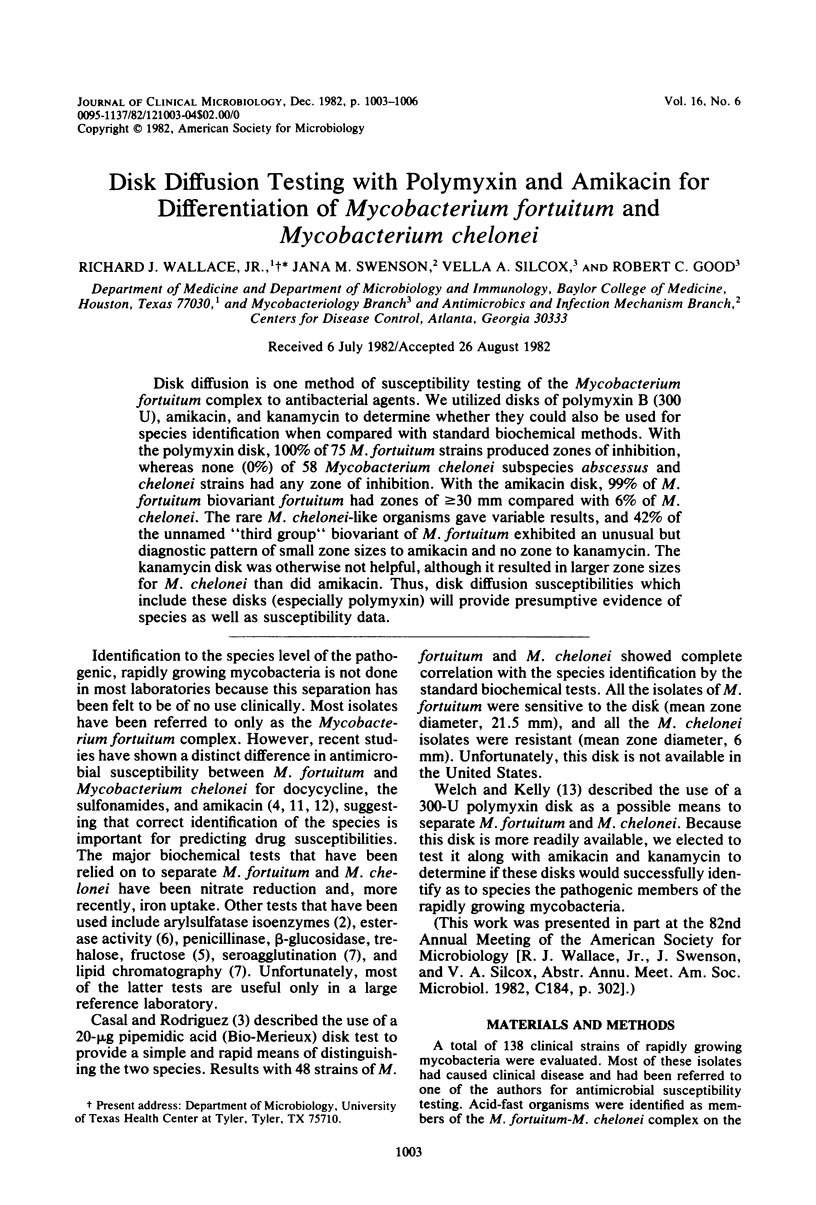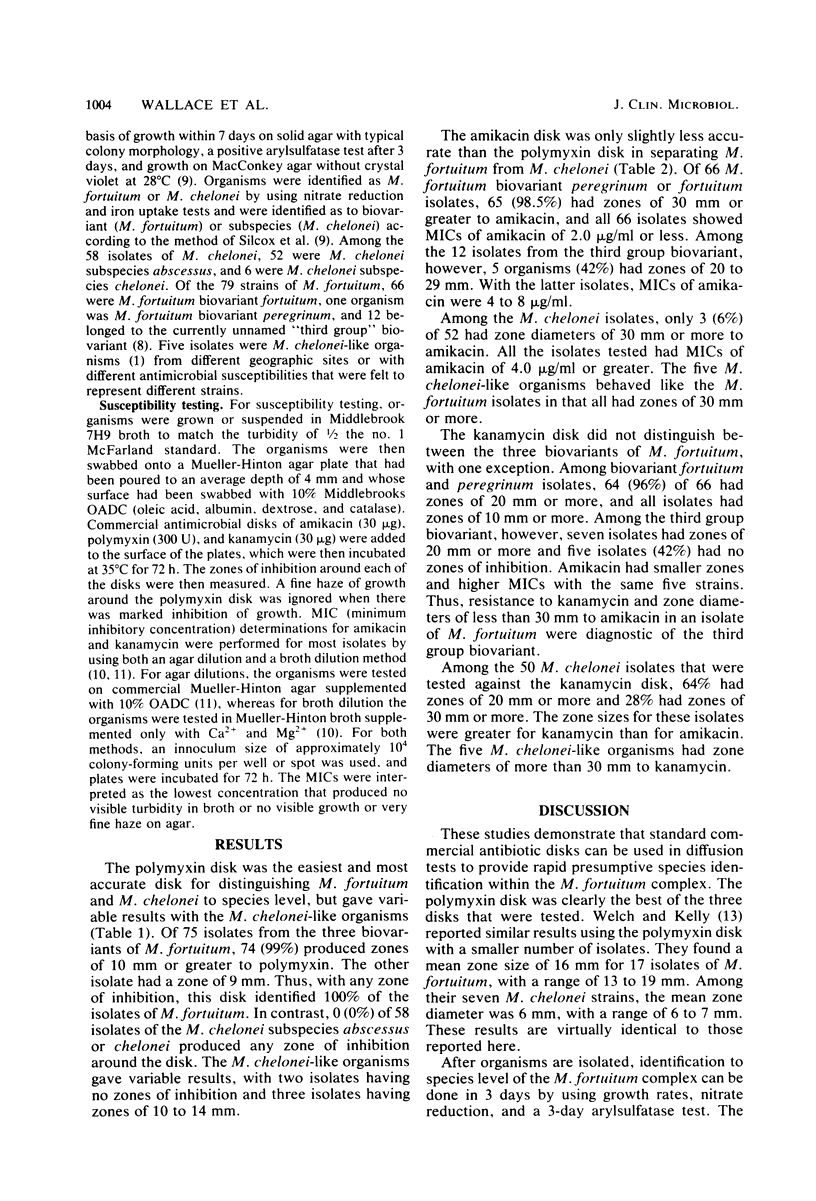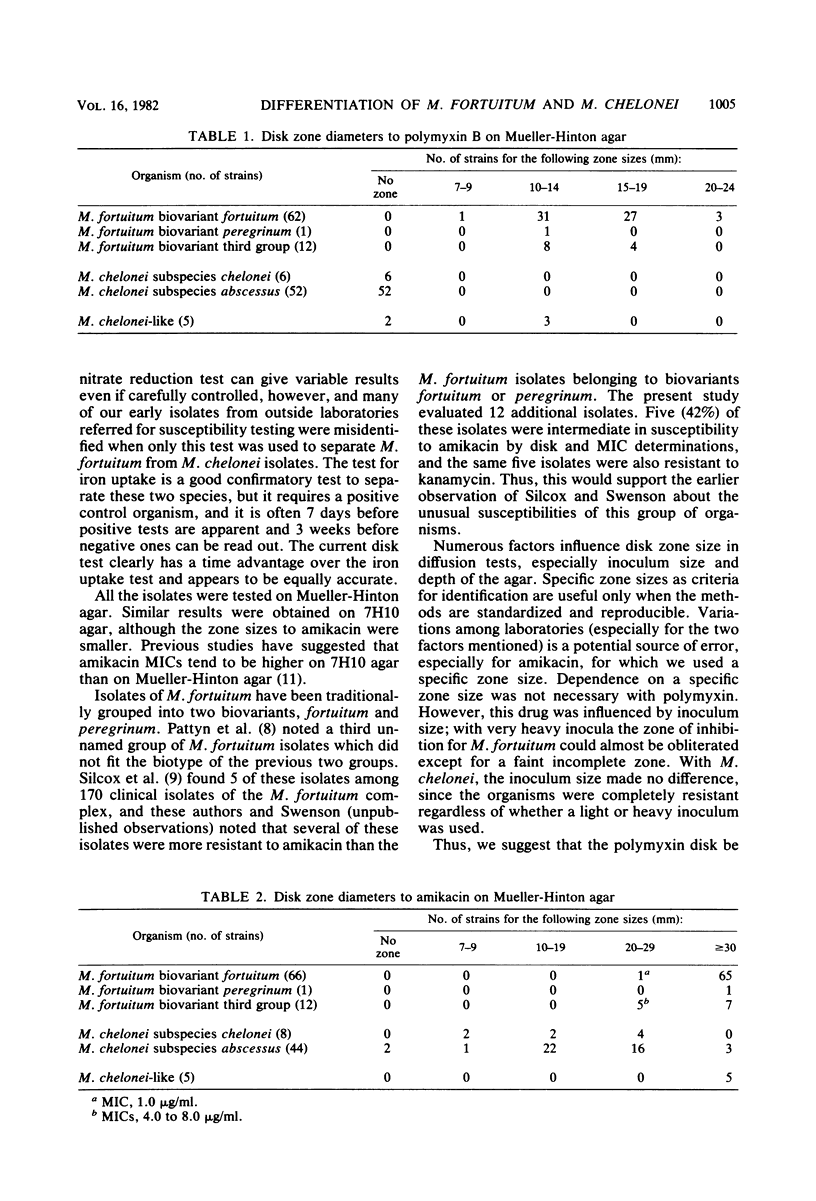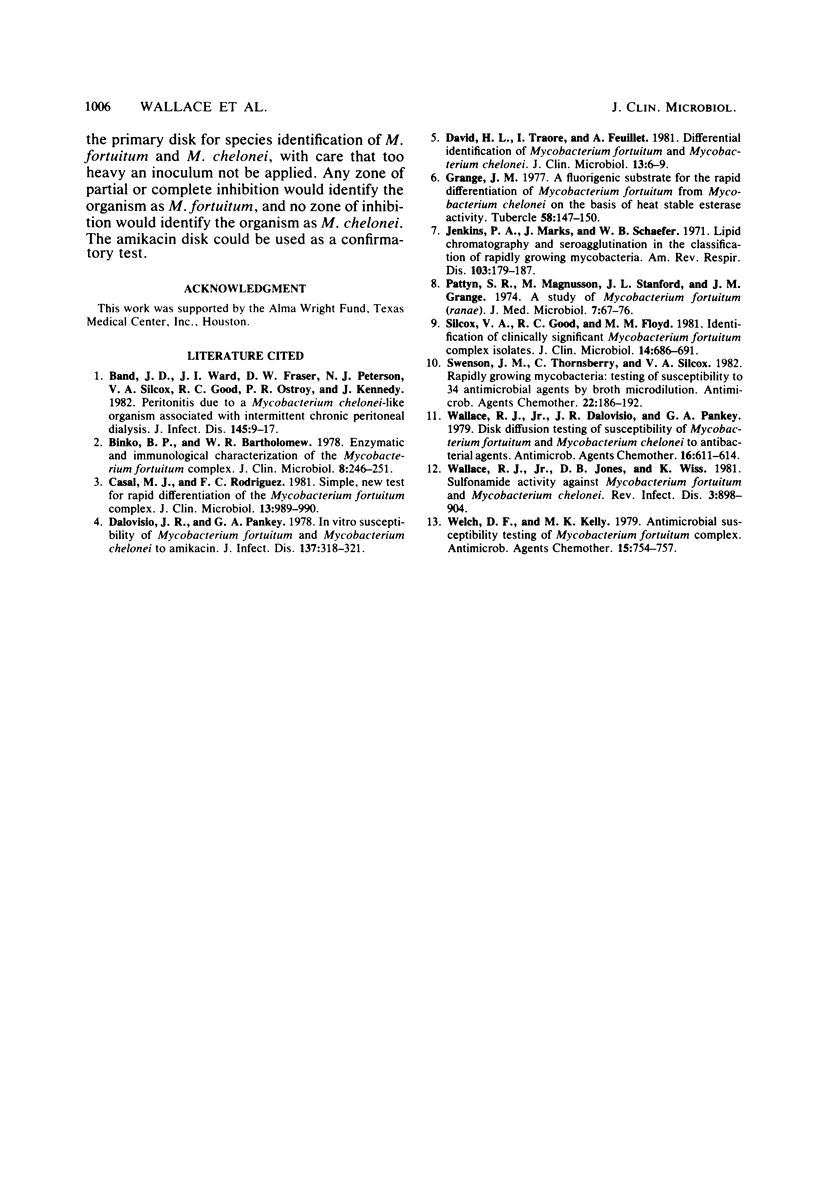Abstract
Disk diffusion is one method of susceptibility testing of the Mycobacterium fortuitum complex to antibacterial agents. We utilized disks of polymyxin B (300 U), amikacin, and kanamycin to determine whether they could also be used for species identification when compared with standard biochemical methods. With the polymyxin disk, 100% of 75 M. fortuitum strains produced zones of inhibition, whereas none (0%) of 58 Mycobacterium chelonei subspecies abscessus and chelonei strains had any zone of inhibition. With the amikacin disk, 99% of M. fortuitum biovariant fortuitum had zones of greater than or equal to 30 mm compared with 6% of M. chelonei. The rare M. chelonei-like organisms gave variable results, and 42% of the unnamed "third group" biovariant of M. fortuitum exhibited an unusual but diagnostic pattern of small zone sizes to amikacin and no zone to kanamycin. The kanamycin disk was otherwise not helpful, although it resulted in larger zone sizes for M. chelonei than did amikacin. Thus, disk diffusion susceptibilities which include these disks (especially polymyxin) will provide presumptive evidence of species as well as susceptibility data.
Full text
PDF



Selected References
These references are in PubMed. This may not be the complete list of references from this article.
- Band J. D., Ward J. I., Fraser D. W., Peterson N. J., Silcox V. A., Good R. C., Ostroy P. R., Kennedy J. Peritonitis due to a mycobacterium chelonei-like organism associated with intermittent chronic peritoneal dialysis. J Infect Dis. 1982 Jan;145(1):9–17. doi: 10.1093/infdis/145.1.9. [DOI] [PubMed] [Google Scholar]
- Binko B. P., Bartholomew W. R. Enzymatic and immunological characterization of the Mycobacterium fortuitum complex. J Clin Microbiol. 1978 Aug;8(2):246–251. doi: 10.1128/jcm.8.2.246-251.1978. [DOI] [PMC free article] [PubMed] [Google Scholar]
- Casal M. J., Rodriguez F. C. Simple, new test for rapid differentiation of the Mycobacterium fortuitum complex. J Clin Microbiol. 1981 May;13(5):989–990. doi: 10.1128/jcm.13.5.989-990.1981. [DOI] [PMC free article] [PubMed] [Google Scholar]
- Dalovisio J. R., Pankey G. A. In vitro susceptiiblity of Mycobacterium fortuitum and Mycobacterium chelonei to amikacin. J Infect Dis. 1978 Mar;137(3):318–321. doi: 10.1093/infdis/137.3.318. [DOI] [PubMed] [Google Scholar]
- David H. L., Traore I., Feuillet A. Differential identification of Mycobacterium fortuitum and Mycobacterium chelonei. J Clin Microbiol. 1981 Jan;13(1):6–9. doi: 10.1128/jcm.13.1.6-9.1981. [DOI] [PMC free article] [PubMed] [Google Scholar]
- Grange J. M. A fluorigenic substrate for the rapid differentiation of Mycobacterium fortuitum from Mycobacterium chelonei on the basis of heat stable esterase activity. Tubercle. 1977 Sep;58(3):147–150. doi: 10.1016/0041-3879(77)90016-2. [DOI] [PubMed] [Google Scholar]
- Jenkins P. A., Marks J., Schaefer W. B. Lipid chromatography and seroagglutination in the classification of rapidly growing mycobacteria. Am Rev Respir Dis. 1971 Feb;103(2):179–187. doi: 10.1164/arrd.1971.103.2.179. [DOI] [PubMed] [Google Scholar]
- Pattyn S. R., Magnusson M., Stanford J. L., Grange J. M. A study of Mycobacterium fortuitum (ranae). J Med Microbiol. 1974 Feb;7(1):67–76. doi: 10.1099/00222615-7-1-67. [DOI] [PubMed] [Google Scholar]
- Silcox V. A., Good R. C., Floyd M. M. Identification of clinically significant Mycobacterium fortuitum complex isolates. J Clin Microbiol. 1981 Dec;14(6):686–691. doi: 10.1128/jcm.14.6.686-691.1981. [DOI] [PMC free article] [PubMed] [Google Scholar]
- Swenson J. M., Thornsberry C., Silcox V. A. Rapidly growing mycobacteria: testing of susceptibility to 34 antimicrobial agents by broth microdilution. Antimicrob Agents Chemother. 1982 Aug;22(2):186–192. doi: 10.1128/aac.22.2.186. [DOI] [PMC free article] [PubMed] [Google Scholar]
- Wallace R. J., Jr, Dalovisio J. R., Pankey G. A. Disk diffusion testing of susceptibility of Mycobacterium fortuitum and Mycobacterium chelonei to antibacterial agents. Antimicrob Agents Chemother. 1979 Nov;16(5):611–614. doi: 10.1128/aac.16.5.611. [DOI] [PMC free article] [PubMed] [Google Scholar]
- Wallace R. J., Jr, Jones D. B., Wiss K. Sulfonamide activity against Mycobacterium fortuitum and Mycobacterium chelonei. Rev Infect Dis. 1981 Sep-Oct;3(5):898–904. doi: 10.1093/clinids/3.5.898. [DOI] [PubMed] [Google Scholar]
- Welch D. F., Kelly M. T. Antimicrobial susceptibility testing of Mycobacterium fortuitum complex. Antimicrob Agents Chemother. 1979 Jun;15(6):754–757. doi: 10.1128/aac.15.6.754. [DOI] [PMC free article] [PubMed] [Google Scholar]


